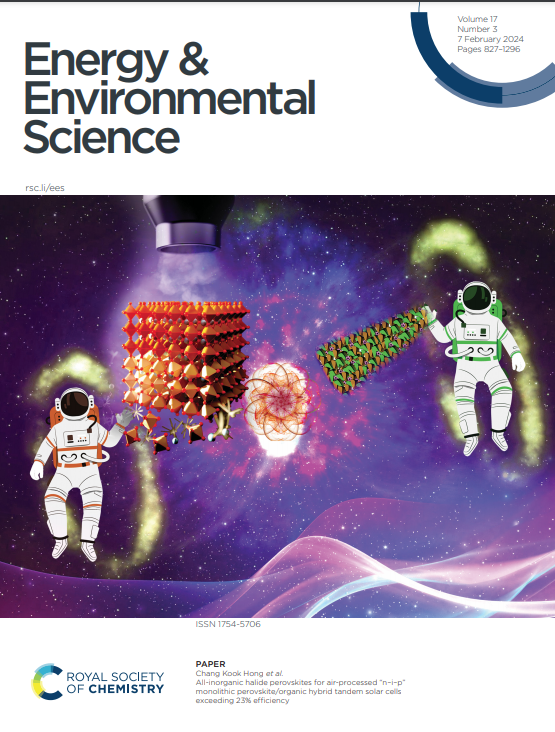Magneto-conversion anode design for unlocking high energy density and dendrite-free hybrid lithium–ion/lithium–metal batteries
IF 30.8
1区 材料科学
Q1 CHEMISTRY, MULTIDISCIPLINARY
引用次数: 0
Abstract
By coupling intercalation with controlled lithium (Li) metal plating, hybrid Li–ion/Li–metal anodes offer a promising route toward higher energy-density and dendrite-free Li batteries. However, conventional graphite-based electroactive hosts inherently suffer from limited capacity and sluggish Li plating kinetics, which constrain further advancement. Here, we introduce a novel magnetically tailored conversion strategy that integrates ferromagnetic transition metal oxides with an interfacial conductive carbon layer under an external magnetic field to significantly increase the energy-density and reversibility of the electrode. The converted ferromagnetic nanoparticles, embedded within a lithiophilic Li2O matrix, regulate spatially uniform Li+ flux and homogenize nucleation barriers via magnetically modulated ionic pathways and interfacial Li kinetics. Concurrently, the intrinsic spin-polarized surface capacitance of the ferromagnetic conversion chemistry is exploited to enhance charge storage and reversibility. Operando X-ray micro-imaging and computational modelling reveal dynamic evolution of Li deposition, showing that micromagnetic fields from magnetized ferromagnetic nanoparticles induce Lorentz force-driven ionic redistribution, guiding compact and dendrite-free Li growth, even at high deposition rates. As a result, a superior reversible capacity of 1400 mAh g−1 is achieved with outstanding cyclability, maintaining a Coulombic efficiency over 99% after 300 cycles and further validating its practical viability in stable full-cell configurations. These insights suggest a new paradigm in hybrid anode design by bridging conversion chemistry with magnetically modulated interfacial Li dynamics.

磁转换阳极设计,解锁高能量密度和无枝晶混合锂离子/锂金属电池
通过耦合插层和可控的锂(Li)金属电镀,混合锂离子/锂金属阳极为实现高能量密度和无枝晶锂电池提供了一条有前途的途径。然而,传统的石墨基电活性基质本身存在容量有限和镀锂动力学缓慢的问题,这制约了其进一步发展。在这里,我们介绍了一种新的磁性定制转换策略,该策略将铁磁性过渡金属氧化物与界面导电碳层集成在外磁场下,以显着提高电极的能量密度和可逆性。转换后的铁磁性纳米颗粒嵌入亲锂的Li2O基质中,通过磁调制的离子路径和界面Li动力学调节空间均匀的Li+通量和均匀的成核屏障。同时,利用铁磁转换化学的本征自旋极化表面电容来增强电荷存储和可逆性。Operando x射线微成像和计算模型揭示了锂沉积的动态演变,表明来自磁化铁磁纳米颗粒的微磁场诱导洛伦兹力驱动的离子再分配,引导致密和无枝晶的锂生长,即使在高沉积速率下也是如此。结果,该电池的可逆容量达到1400 mAh g−1,具有出色的可循环性,在300次循环后库仑效率保持在99%以上,进一步验证了其在稳定的全电池配置下的实际可行性。这些见解表明,通过桥接转换化学与磁调制界面Li动力学的混合阳极设计的新范式。
本文章由计算机程序翻译,如有差异,请以英文原文为准。
求助全文
约1分钟内获得全文
求助全文
来源期刊

Energy & Environmental Science
化学-工程:化工
CiteScore
50.50
自引率
2.20%
发文量
349
审稿时长
2.2 months
期刊介绍:
Energy & Environmental Science, a peer-reviewed scientific journal, publishes original research and review articles covering interdisciplinary topics in the (bio)chemical and (bio)physical sciences, as well as chemical engineering disciplines. Published monthly by the Royal Society of Chemistry (RSC), a not-for-profit publisher, Energy & Environmental Science is recognized as a leading journal. It boasts an impressive impact factor of 8.500 as of 2009, ranking 8th among 140 journals in the category "Chemistry, Multidisciplinary," second among 71 journals in "Energy & Fuels," second among 128 journals in "Engineering, Chemical," and first among 181 scientific journals in "Environmental Sciences."
Energy & Environmental Science publishes various types of articles, including Research Papers (original scientific work), Review Articles, Perspectives, and Minireviews (feature review-type articles of broad interest), Communications (original scientific work of an urgent nature), Opinions (personal, often speculative viewpoints or hypotheses on current topics), and Analysis Articles (in-depth examination of energy-related issues).
 求助内容:
求助内容: 应助结果提醒方式:
应助结果提醒方式:


